Posts By arnellebasi
Personalized Learning Project: Acoustic Guitar Update #1
As promised to all my bloggers, here is an update on my musical journey of learning the acoustic guitar. I have been on track so far and continue to practice my instrument an hour a week. Some of the challenges I have come across thus far are finding the time to practice multiple times instead of practicing for an hour all at once, practicing when I was home alone and being motivated to practice.
By Wednesday, January 29th, 2020, I set a goal to be able to learn how to properly hold the guitar & learn how to tune the guitar. I began my journey by using the internet to access multiple videos and websites and research on how to hold the guitar properly. By making sure I was doing this correctly, On January 27th, in class I verified my technique with Anita Prest. During this same class, I was lucky enough to have a classmate Maddie Osgarby assist me in tuning my guitar. I started off by downloading the app Guitar Tuner, and what the app does is it demonstrates and shows that the chord you play makes the sound it is supposed to make. This app allowed me to tune my guitar, luckily my guitar only had one chord the G chord, which was out of tune. I also watched a YouTube video, which showed me what to do.
Here are a few videos and literature of how to hold the guitar properly for beginners, which I recommend watching:
http://https://www.youtube.com/watch?v=RTR12eM1-Xc
https://www.wikihow.com/Hold-a-Guitar
Here are two images of two similar but a bit different way to hold the guitar properly:


Below is an image of myself holding the guitar correctly and properly:

Below is an image of the anatomy of a guitar, this diagram will be useful for the future, and when watching the videos attached this will clarify any confusion.
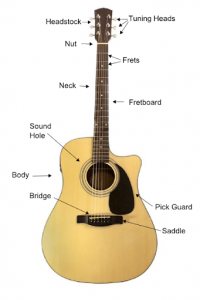
Here is the link, I recommend using if you are attempting to tune your guitar: https://www.youtube.com/watch?v=JzpVGEzcvC8
Next Week: Before February 15th, I would like to find and learn music sheets and notes for my selected song. (Practice the chords) and practice the song with musical sheets. However, next I will find the strumming pattern by doing more extensive research for the song Brown Eyed Girl by Van Morrison and begin working on my strumming pattern.
Kahoot: What is it?
This week we researched the learning platform of Kahoot, in regard to, our question of how can Kahoot be used as a resource in the classroom & how does it connect to formative and summative assessment?
CREATE PLAY SHARE
Kahoot is a game based learning platform that makes it easy to create, share and play learning games or trivia quizzes in minutes. This interactive game allows for students to have fun while learning. It also acts as a form of assessment, whether it be formative or summative assessment (depending on how the teacher decides to use the game). Kahoot is available, easily accessible and can be used for all ages. Students may work independently or in teams to answer the questions posed by the teacher.
Kahoot is known as a formative assessment tool as children are involved in a game that evaluates their understanding and learnings. However, unlike an essay where a student can get individual feedback, it is a competitive model that evaluates the classrooms understandings as a whole. There can be feedback, however it is done based on the classes results rather than the individual project. This method allows to check students understanding and typically enhances what is being learned as they occur throughout a unit rather than just at the end (summative assessment). Although, Kahoot can also support summative assessment as children are able to create quizzes for their pears based on their learnings.
Kahoot may not be the most effective formative assessment tool but serves as a good means to support learning as it encourages students to learn and see where their classmates are at, without singling out one child (as they do not know who answered wrong). Another digital platform that came up in our research was “Formative”. This digital platform is similar however it also provides students with more options to respond (drawing, short answer and multiple choice). As such, this platform can be an extension to Kahoot and learning.
Additional Resources:
https://edutechsage.com/tag/advantages-of-kahoot/
https://files.eric.ed.gov/fulltext/EJ1141198.pdf
Partner: Brittany Johnson
Health and Fitness Update #2
This week, I was able to solidify a routine for working out and eating healthy. I began my week with meal prep Sunday evening, I made several salads (Greek, Caesar, quinoa, bean and taco), marinated chicken breast and prepped rice with vegetables for the week. I committed to making my smoothie every evening before going to sleep for the next day, therefore I would not feel rushed in the morning. In my smoothies, I would add protein powder, a banana, yogurt and frozen fruits to ensure I was being constant. I also ensured I was eating accurate food servings and amounts by using Canada’s food guide as a reference. (https://food-guide.canada.ca/en/). In relation to working out, I worked out Sunday, Wednesday and Saturday for an hour and a half on Wednesday and Saturday, but on Sunday I worked out for two hours. I focused my workouts on working out the back, legs, arms, chest, abs and butt. Although the list is long, I am trying to slow down my workouts and try and implement the proper techniques I learned rather than doing the exercise for the quantity over the quality. As the slower, you do the exercise the more you will feel the burn.
During this week, I remembered to take pictures of my workout, therefore you could see what machines I use as well as some of my smoothies. The first picture is a representation of my smoothie preparation that I make every evening, which I store in the fridge overnight. The second and third picture are images of my smoothies (blended and ready to drink). The fourth and fifth picture portrays the cardio machine after I have finished running, in the images you can see how long I run for and at what pace. Finally, the last two images are of myself. In one image I am using the leg press at 110 pounds (one of my favourite machines) and in the other image it is a mirror selfie of myself as I was doing free weights.

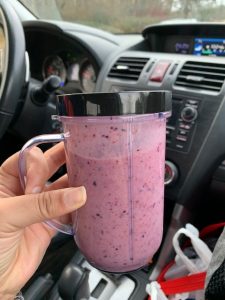
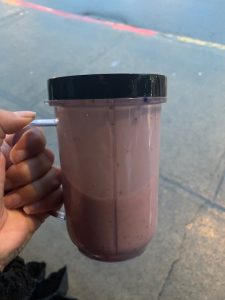


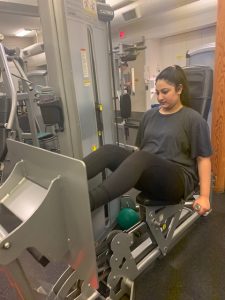

Impressions and Thoughts on PSII
PSII is the pacific school of innovation and inquiry. This school is an alternative school also known as a special education school. This school serves diverse learners and allows them to learn at their own pace, and how they would like. Today, we had the opportunity to visit PSII and I am grateful to have had the opportunity to visit, explore and gain new knowledge. Although this alternative school was directed towards secondary students, I believe the idea and structure of learning should be also implemented into elementary schools. Learning through inquiry, allows students to work at their own pace and learn about things that interest them. While we were at PSII, the principal, Jeff Hopkins spoke to us about what the school offers, its pedagogy and informed us about some technology tools their students use. I found it very interesting to hear that all students are given a laptop and that they use Trello, to stay on top of their work and therefore their teachers can also see what they are doing with their inquiry questions. Another thing I found intriguing was that there is no structured schedule or bells to tell the students to change subjects, however the teachers put on classes and they are optional for the students to attend. PSII is a small school of 96 students, but its authentic personalization makes it such an accepting environment to learn in. Jeff Hopkins stated that a majority of their students are on the spectrum or struggle with anxiety and depression, therefore they had sensory rooms to help these students. Finally, my experience and thoughts on PSII is breathtaking. I was truly amazing and inspired by the learning and the projects many students were working on, as they are ultimately designing their own learning paths. As future elementary school teachers, we need to learn from this visit and apply this technique and pedagogy of learning into our teachings.
Below is a picture of the common area of the pacific school of innovation and inquiry, where students of all grades in secondary school may communicate and collaborate with their classmates. This type of learning environment allows children to bounce ideas off of each other and gain new perspectives about their inquiry topics and subjects.

Health and Fitness Update
Over the past week, and weekend I focused on small changes with my diet and working out three times a week for an hour and a half each. Since I haven’t spent much time in the gym, I brought a friend with me, who taught me the proper technique of how to do each exercise. Due to the fact I was only working out three times a week, instead of just focusing on one part of my body, I focused on all parts including cardio. For my workout routine, I started to run for 15 minutes on the treadmill, then focused on legs, abs, back, chest, shoulders and butt. Except on Sunday this week I spent a longer time working out (2 hours) and ran for 25 minutes (picture below).

In this order, I rotated around the specific machines and finished my workout with stretching out. For my diet, I focused on having a smoothie every day in the morning with a special K protein bar. I alternated days, with having salads and sandwiches for lunch and for dinner I ensured I was keeping my proportions small.
Below is a daily schedule of what I ate, and when I worked out:
Monday: Smoothie with a special K bar for breakfast, salad from Thrifty’s for lunch, veggies and rice for dinner.
Tuesday: Smoothie with a special K bar for breakfast, sandwich (homemade) for lunch, salad and chicken breast (protein) for dinner.
Wednesday: Smoothie with a special K bar for breakfast, salad from Thrifty’s for lunch, veggies and rice for dinner. (WORKOUT)
Thursday: Smoothie with a special K bar for breakfast, sandwich (homemade) for lunch, salad and chicken breast (protein) for dinner.
Friday: Smoothie with a special K bar for breakfast, salad from Thrifty’s for lunch, veggies and rice for dinner.
Saturday: Smoothie with a special K bar for breakfast, sandwich (homemade) for lunch, salad and chicken breast (protein) for dinner. (WORKOUT)
Sunday:Smoothie with a special K bar for breakfast, salad from Thrifty’s for lunch, veggies and rice for dinner. (WORKOUT)
Unfortunately, I was unable to take pictures as the gym was pretty busy, however in next week’s blog post I will be posting more pictures of my smoothies and workout routines. However, attached is one of the recipes I used for my smoothies (video).
Reflection on Inquiry Based Learning
I believe that inquiry based learning is a diverse and accepting way to include every individual child’s thoughts and ideas. Inquiry based learning allows student’s the opportunity to have a voice and a choice of what they are learning. Students are more likely to be intrigued and motivated to learn if they are choosing what they are learning and how they are learning the material. Inquiry based learning allows students to develop their communications skills, collaborating outside of the classroom, helps them deal with problem-solving and allows them to participate in creation.
There are four types of inquiries which are; confirmation, structured, guided and open inquiry. Confirmation inquiry is when learners are given a question, and there is an end result, which is already known. Structured inquiry is when learners are given the question, but he goal is to provide an explanation that is already supported by the evidence gathered. Guided inquiry is when the learners are only given a question with no answers or results. Open inquiry is when the learners form their own questions and they must show the results in what they have found or find.
There are several benefits for inquiry based learning which include; that it reinforces curriculum content, it warms up the brain for learning, it promotes a deeper understanding of content, it helps make learning rewarding, builds initiative and self-direction, works in almost any classroom (depending on the age group) and it offers differentiated instruction.
Personal Connections to Inquiry-Based Learning: I had several opportunities in Elementary school to participate in inquiry based learning, whether this was in partners, individual or groups I found it to be very interesting and useful. In high school, I did a few individual inquiry- based learning projects, which allowed me to explore and research topics of my choice. By having a choice, I was more interested and motivated on coming to class and working on my project.
*I have also attached two spate Youtube videos which I found very useful and interesting. One video discusses the importance of inquiry based learning, and the other video explains what inquiry-based learning is.
Inquiry Project Idea & Reasoning
After much thought and consideration about what to do for my free Inquiry, I have finally settled on an idea. I have been wanting to improve my health and most importantly fitness for a few years now and I finally have a reason and motivation to do so. In high school, I was very active and involved in multiple sports such as: soccer, softball, basketball, tennis, golf and volleyball. However, three years ago when I moved from North Delta BC to Victoria BC, I joined a women’s softball team. However, because of starting my first year at university and the stress of looking for a job I wasn’t able to find time to work out and felt rushed when I was at home which led to me eating very unhealthy and not finding the time to work out. In early January, when I found out about this inquiry I knew what I wanted to do. Therefore, for my inquiry project I would like to improve my health and fitness. For starters to improve my fitness, I will make sure I work out three times a week at Henderson Recreation Centre (https://www.oakbay.ca/parks-recreation/facilities-rentals/recreation-centres/henderson-recreation-centre)for an hour to an hour and a half each time. This lifestyle change is possible as I work at Henderson, and I can workout after work. I will be focusing on all parts of the body as I try to strengthen my muscles and loose body fat. However, to improve my health I will need to change my diet and focus on eating healthy. To adjust to my diet changes I will begin by having a smoothie with a protein bar every morning. This is to ease into it, after the first week of making this small change to my diet I will ease into changing my lunches, then dinners. In order, to succeed and to accomplish my goals, I will have to continue to be motivated.
Henderson Gym Video:http://rivlava.ca/media/facilityDetails.php?searchTerm=Henderson%20Recreation%20Centre#GYM
Lesson Plans vs Learning Plans?
What is the difference between a learning plan and a lesson plan? A learning plan is a document that is used to plan learning. Whereas, a lesson plan is typically a step by step guide/ outline with small goals and objectives the students will accomplish during a day’s work, week’s work or even a semester long.
The advantages of lesson-planning include; it inspires the teacher to improve the further lessons, it helps the teacher in evaluating his teaching, it develops self confidence in the teacher, proper care is taken on take into consideration, the level and previous knowledge of students, the teaching matter is organized in a specific time frame., it inspires the teacher to ask proper and important questions, it provides guidance for teachers to understand what or what not they should or shouldn’t teach and it helps in creating the interest of students towards the lesson. However, some of the limitations of lesson-planning include, that sometimes simple matters become complicated, teachers cannot work/ teach independently and there is a lack of flexibility in lesson planning, where the teaching process becomes more difficult.
Why you should develop a personalized learning plan? There are several reasons as to why you should develop personalized learning plans, some of which include; One size does not fit all, and learning experience needs to be customized to suit the learner’s expectations. Learners have different learning styles. Learners come with different proficiency levels. Learners want the flexibility to pick learning elements that interest them. Given their role, only a part of the online training is relevant.
URL: https://www.eidesign.net/5-reasons-why-you-should-develop-a-personalized-learning-plan/
As a teacher candidate, it is crucial to have the knowledge to create a learning plan. When creating a learning plan the first step of action that needs to be taken is to measure and determine what needs to be learned, then setting simple and easy goals for the students, which are possible to achieve, then the next step would be to allow the students to choose how they will want to learn, as students all learn very differently this step is crucial. After giving student voice and choice, the next step would be to asses frequently, evaluate and reflect as well as give the students ongoing feedback. (This is an example of formative assessment). Finally, the last step in creating a learning plan would be to track the progress of each student by having them create a digital or non-digital portfolio.
LEARNING PLANS VERSUS LESSON PLANS
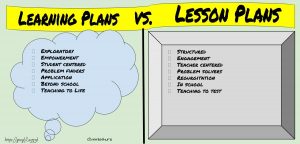
Process of Setting Up WordPress

Welcome to my first blog post!
The process of setting up WordPress for me in Technology Innovation in Education went smoothly and fairly quickly. The instructions that were given out, were clear and made my job efficient and easy.
What is WordPress?
WordPress is a system that lets you create pages or posts without having to learn all that complicated HTML code.
I believe that using a blog in an educational setting demonstrates professionalism and organization skills. Blogs may be used though a variety of different subjects and used by all ages. Ultimately, by incorporating blog usage into the classroom setting, as teacher candidates we are allowing students to have a choice and to share their opinions on related subjects. Blog posts, especially at a university level allows students to share, contrast and compare their work with others, and also allows them to gain new perspectives about similar subjects.